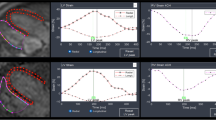Abstract
Background
Cardiac magnetic resonance (CMR) strain can be assessed with feature-tracking (FT), which utilizes a post-processing algorithm to quantify myocardial deformation on routine cine images, and strain-encoding magnetic resonance imaging (SENC), which uses parallel magnetization tags combined with out-of-plane phase-encoding gradients to quantify deformation. Assessing agreement is critical to determine whether results can be translated between methods. We compared SENC to FT in the assessment of left ventricle (LV) global longitudinal strain (GLS) and global circumferential strain (GCS) in a cohort of pediatric and adult congenital heart disease (ACHD) patients.
Methods
Pediatric subjects and ACHD patients underwent CMR on 1.5 T Siemens scanners, including balanced steady-state-free precession (bSSFP) cine imaging and SENC acquisitions in apical two and four chamber, left ventricular outflow tract, and short axis views. bSSFP cine imaging FT analysis was completed with Medis QStrain. Myocardial Solutions MyoStrain was used to analyze SENC. Correlation was assessed by Spearman’s rank correlation coefficient. Agreement between techniques was assessed with concordance correlation coefficient (CCC) and Bland–Altman.
Results
The cohort included 134 patients, 75 with congenital heart disease (56%). The median age was 16.3 years (IQR 13.7, 19.5). Median LV ejection fraction was 57% (IQR 54.4, 61.6). SENC and FT were in poor agreement for GLS (Spearman’s ρ = 0.58, p < 0.001; CCC 0.24) and GCS (Spearman’s ρ = 0.29, p < 0.001; CCC 0.03).
Conclusion
There was poor agreement between SENC and FT derived GLS and GCS in a cohort of pediatric and ACHD patients, suggesting that SENC and FT cannot be used interchangeably.



Similar content being viewed by others
Data Availability
The datasets generated during and/or analyzed during the current study are available from the corresponding author on reasonable request.
Code Availability
Not applicable.
Abbreviations
- ACHD:
-
Adult congenital heart disease
- A2C:
-
Apical two chamber
- A4C:
-
Apical four chamber
- bSSFP:
-
Balanced steady-state-free precession pulse sequence
- CMR:
-
Cardiac magnetic resonance
- DENSE:
-
Displacement-tracking with stimulated echoes
- EDV:
-
End diastolic volume
- ESV:
-
End systolic volume
- EF:
-
Ejection fraction
- FT:
-
Feature-tracking
- GCS:
-
Global circumferential strain
- GLS:
-
Global longitudinal strain
- HARP:
-
Harmonic phase magnetic resonance
- LGE:
-
Late gadolinium enhancement
- LV:
-
Left ventricle
- LVOT:
-
Left ventricular outflow tract
- PSIR:
-
Phase-sensitive inversion recovery
- SAX:
-
Short axis
- SENC:
-
Strain-encoding magnetic resonance imaging
References
Buss SJ, Breuninger K, Lehrke S, Voss A, Galuschky C, Lossnitzer D, Andre F, Ehlermann P, Franke J, Taeger T, Frankenstein L, Steen H, Meder B, Giannitsis E, Katus HA, Korosoglou G (2015) Assessment of myocardial deformation with cardiac magnetic resonance strain imaging improves risk stratification in patients with dilated cardiomyopathy. Eur Heart J Cardiovasc Imaging 16:307–315
Diller GP, Kempny A, Liodakis E, Alonso-Gonzalez R, Inuzuka R, Uebing A, Orwat S, Dimopoulos K, Swan L, Li W, Gatzoulis MA, Baumgartner H (2012) Left ventricular longitudinal function predicts life-threatening ventricular arrhythmia and death in adults with repaired tetralogy of fallot. Circulation 125:2440–2446
Moon TJ, Choueiter N, Geva T, Valente AM, Gauvreau K, Harrild DM (2015) Relation of biventricular strain and dyssynchrony in repaired tetralogy of fallot measured by cardiac magnetic resonance to death and sustained ventricular tachycardia. Am J Cardiol 115:676–680
Poterucha JT, Kutty S, Lindquist RK, Li L, Eidem BW (2012) Changes in left ventricular longitudinal strain with anthracycline chemotherapy in adolescents precede subsequent decreased left ventricular ejection fraction. J Am Soc Echocardiogr 25:733–740
Romano S, Judd RM, Kim RJ, Kim HW, Klem I, Heitner JF, Shah DJ, Jue J, White BE, Indorkar R, Shenoy C, Farzaneh-Far A (2018) Feature-tracking global longitudinal strain predicts death in a multicenter population of patients with ischemic and nonischemic dilated cardiomyopathy incremental to ejection fraction and late gadolinium enhancement. JACC Cardiovasc Imaging 11:1419–1429
Saito M, Negishi K, Eskandari M, Huynh Q, Hawson J, Moore A, Koneru S, Foster S, Marwick TH (2015) Association of left ventricular strain with 30-day mortality and readmission in patients with heart failure. J Am Soc Echocardiogr 28:652–666
Suerken CK, D’Agostino RB Jr, Jordan JH, Melendez GC, Vasu S, Lamar ZS, Hundley WG (2020) Simultaneous left ventricular volume and strain changes during chemotherapy associate with 2-year postchemotherapy measures of left ventricular ejection fraction. J Am Heart Assoc 9:e015400
Claus P, Omar AMS, Pedrizzetti G, Sengupta PP, Nagel E (2015) Tissue tracking technology for assessing cardiac mechanics: principles, normal values, and clinical applications. JACC Cardiovasc Imaging 8:1444–1460
Osman NF, Sampath S, Atalar E, Prince JL (2001) Imaging longitudinal cardiac strain on short-axis images using strain-encoded MRI. Magn Reson Med 46:324–334
Amzulescu MS, De Craene M, Langet H, Pasquet A, Vancraeynest D, Pouleur AC, Vanoverschelde JL, Gerber BL (2019) Myocardial strain imaging: review of general principles, validation, and sources of discrepancies. Eur Heart J Cardiovasc Imaging 20:605–619
Augustine D, Lewandowski AJ, Lazdam M, Rai A, Francis J, Myerson S, Noble A, Becher H, Neubauer S, Petersen SE, Leeson P (2013) Global and regional left ventricular myocardial deformation measures by magnetic resonance feature tracking in healthy volunteers: comparison with tagging and relevance of gender. J Cardiovasc Magn Reson 15:8
Bucius P, Erley J, Tanacli R, Zieschang V, Giusca S, Korosoglou G, Steen H, Stehning C, Pieske B, Pieske-Kraigher E, Schuster A, Lapinskas T, Kelle S (2019) Comparison of feature tracking, fast-SENC, and myocardial tagging for global and segmental left ventricular strain. ESC Heart Fail 7:523
Cao JJ, Ngai N, Duncanson L, Cheng J, Gliganic K, Chen Q (2018) A comparison of both DENSE and feature tracking techniques with tagging for the cardiovascular magnetic resonance assessment of myocardial strain. J Cardiovasc Magn Reson 20:26
Goto Y, Ishida M, Takase S, Sigfridsson A, Uno M, Nagata M, Ichikawa Y, Kitagawa K, Sakuma H (2017) Comparison of displacement encoding with stimulated echoes to magnetic resonance feature tracking for the assessment of myocardial strain in patients with acute myocardial infarction. Am J Cardiol 119:1542–1547
Ibrahim EH, Stojanovska J, Hassanein A, Duvernoy C, Croisille P, Pop-Busui R, Swanson SD (2018) Regional cardiac function analysis from tagged MRI images. Comparison of techniques: Harmonic-Phase (HARP) versus Sinusoidal-Modeling (SinMod) analysis. Magn Reson Imaging 54:271–282
Ohyama Y, Ambale-Venkatesh B, Chamera E, Shehata ML, Corona-Villalobos CP, Zimmerman SL, Hassoun PM, Bluemke DA, Lima JAC (2015) Comparison of strain measurement from multimodality tissue tracking with strain-encoding MRI and harmonic phase MRI in pulmonary hypertension. Int J Cardiol 182:342–348
van Everdingen WM, Zweerink A, Nijveldt R, Salden OAE, Meine M, Maass AH, Vernooy K, De Lange FJ, van Rossum AC, Croisille P, Clarysse P, Geelhoed B, Rienstra M, Van Gelder IC, Vos MA, Allaart CP, Cramer MJ (2018) Comparison of strain imaging techniques in CRT candidates: CMR tagging, CMR feature tracking and speckle tracking echocardiography. Int J Cardiovasc Imaging 34:443–456
Orwat S, Kempny A, Diller GP, Bauerschmitz P, Bunck A, Maintz D, Radke RM, Baumgartner H (2014) Cardiac magnetic resonance feature tracking: a novel method to assess myocardial strain. Comparison with echocardiographic speckle tracking in healthy volunteers and in patients with left ventricular hypertrophy. Kardiol Pol 72:363–371
Pryds K, Larsen AH, Hansen MS, Grondal AYK, Tougaard RS, Hansson NH, Clemmensen TS, Logstrup BB, Wiggers H, Kim WY, Botker HE, Nielsen RR (2019) Myocardial strain assessed by feature tracking cardiac magnetic resonance in patients with a variety of cardiovascular diseases - a comparison with echocardiography. Sci Rep 9:11296
Korosoglou G, Gitsioudis G, Voss A, Lehrke S, Riedle N, Buss SJ, Zugck C, Giannitsis E, Osman NF, Katus HA (2011) Strain-encoded cardiac magnetic resonance during high-dose dobutamine stress testing for the estimation of cardiac outcomes: comparison to clinical parameters and conventional wall motion readings. J Am Coll Cardiol 58:1140–1149
Feisst A, Kuetting DLR, Dabir D, Luetkens J, Homsi R, Schild HH, Thomas D (2018) Influence of observer experience on cardiac magnetic resonance strain measurements using feature tracking and conventional tagging. Int J Cardiol Heart Vasc 18:46–51
Voigt JU, Pedrizzetti G, Lysyansky P, Marwick TH, Houle H, Baumann R, Pedri S, Ito Y, Abe Y, Metz S, Song JH, Hamilton J, Sengupta PP, Kolias TJ, d’Hooge J, Aurigemma GP, Thomas JD, Badano LP (2015) Definitions for a common standard for 2D speckle tracking echocardiography: consensus document of the EACVI/ASE/Industry Task Force to standardize deformation imaging. J Am Soc Echocardiogr 28:183–193
Acknowledgements
We thank the cardiac magnetic resonance technologists, Shannon Bozeman and Dana Fuhs, for their efforts in implementing the SENC sequences and continuously optimizing the acquisition of images. We also thank Nael Osman and Amanda Rice with Myocardial Solutions for providing education on the use of SENC imaging and their support of this study.
Funding
This work was supported by CTSA award No. UL1 TR002243 from the National Center for Advancing Translational Sciences. Its contents are solely the responsibility of the authors and do not necessarily represent official views of the National Center for Advancing Translational Sciences or the National Institutes of Health.
Author information
Authors and Affiliations
Contributions
JDC contributed to the conception and design of the study, acquisition, analysis and interpretation of data, and primarily drafted the manuscript. KGD, BA, and JGW contributed to the acquisition and analysis of data. JCS contributed to the analysis and interpretation of data. DP contributed to the acquisition and analysis of data and substantively revised the manuscript. JHS contributed to the conception and design of the study, acquisition, analysis and interpretation of data, and substantively revised the manuscript. All authors read, critically reviewed and approved the final manuscript.
Corresponding author
Ethics declarations
Conflict of interest
The authors declare that they have no competing interests. Myocardial solutions provided analysis software but had no input into design of study, analysis, or interpretation.
Ethical Approval
The study was approved by the Vanderbilt University Medical Center Institutional Review Board (IRB #161524).
Consent to Participate
For all pediatric subjects, guardians provided informed consent and the subject provided assent. All adult subjects provided informed consent.
Consent for Publication
Not applicable.
Additional information
Publisher's Note
Springer Nature remains neutral with regard to jurisdictional claims in published maps and institutional affiliations.
Rights and permissions
About this article
Cite this article
Chew, J.D., George-Durrett, K., Acheampong, B. et al. Comparison of Strain-Encoding and Feature-Tracking Derived Myocardial Deformation Assessment of Left Ventricular Function in a Pediatric and Adult Congenital Heart Disease Cohort. Pediatr Cardiol 43, 1338–1348 (2022). https://doi.org/10.1007/s00246-022-02856-6
Received:
Accepted:
Published:
Issue Date:
DOI: https://doi.org/10.1007/s00246-022-02856-6




